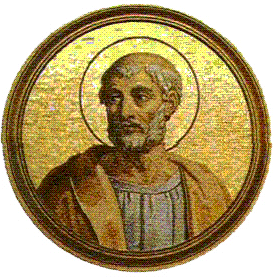 Pope Clement I[…], is the first of the successors of St. Peter of whom anything definite is known, and he is the first of the “Apostolic Fathers”. His feast is celebrated 23 November. He has left one genuine writing, a letter to the Church of Corinth, and many others have been attributed to him.
Pope Clement I[…], is the first of the successors of St. Peter of whom anything definite is known, and he is the first of the “Apostolic Fathers”. His feast is celebrated 23 November. He has left one genuine writing, a letter to the Church of Corinth, and many others have been attributed to him.
[…]
Of the life and death of St, Clement nothing is known. The apocryphal Greek Acts of his martyrdom were printed by Cotelier in his “Patres Apost.” (1724, I, 808; reprinted in Migne, P.G., II, 617, best edition by Funk, “Patr. Apost.”, II, 28). They relate how he converted Theodora, wife of Sisinnius, a courtier of Nerva, and (after miracles) Sisinnius himself and four hundred and twenty-three other persons of rank. Trajan banishes the pope to the Crimea, where he slakes the thirst of two thousand Christian confessors by a miracle. The people of the country are converted, seventy-five churches are built. Trajan, in consequence, orders Clement to be thrown into the sea with an iron anchor. But the tide every year recedes two miles,revealing a Divinely built shrine which contains the martyr’s bones. This story is not older than the fourth century. It is known to Gregory of Tours in the sixth. About 868 St. Cyril, when in the Crimea on the way to evangelize the Chazars, dug up some bones in a mound (not in a tomb under the sea), and also an anchor. These were believed to be the relics of St. Clement. They were carried by St. Cyril to Rome, and deposited by Adrian II with those of St. Ignatius of Antioch in the high altar of the basilica of St. Clement in Rome. The history of this translation is evidently quite truthful, but there seems to have been no tradition with regard to the mound, which simply looked a likely place to be a tomb. The anchor appears to be the only evidence of identity but we cannot gather from the account that it belonged to the scattered bones. (See Acta SS., 9 March, II, 20.) St. Clement is first mentioned as a martyr by Rufinus (c. 400). Pope Zozimus in a letter to Africa in 417 relates the trial and partial acquittal of the heretic Caelestius in the basilica of St. Clement; the pope had chosen this church because Clement had learned the Faith from St. Peter, and had given his life for it (Ep. ii). He is also called a martyr by the writer known as Praedestinatus (c. 430) and by the Synod of Vaison in 442. Modern critics think it possible that his martyrdom was suggested by a confusion with his namesake, the martyred consul. But the lack of tradition that he was buried in Rome is in favour of his having died in exile.
Text taken from:
Chapman, John. “Pope St. Clement I.” The Catholic Encyclopedia. Vol. 4.
New York: Robert Appleton Company, 1908. 24 Jun. 2013.
